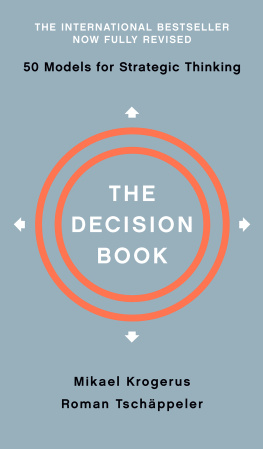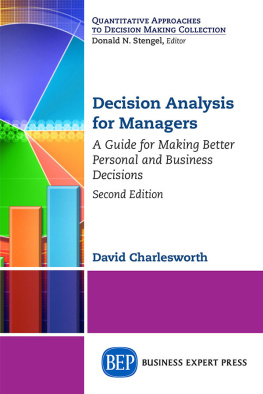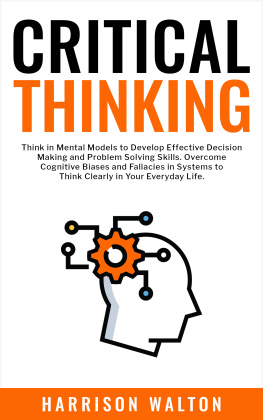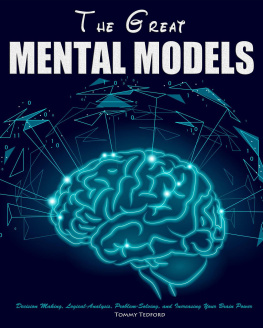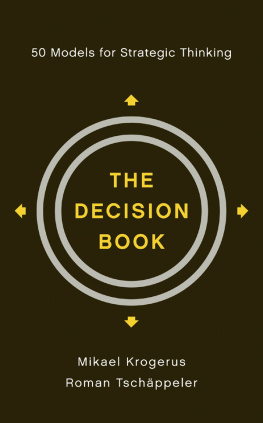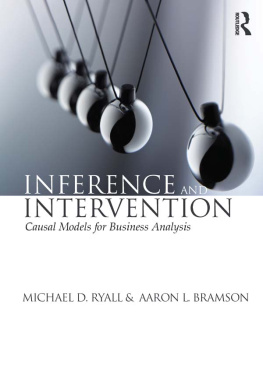
THE DECISION BOOK
FIFTY MODELS FOR STRATEGIC THINKING
Mikael Krogerus
Roman Tschppeler
Translated by Jenny Piening
WITH ILLUSTRATIONS BY PHILIP EARNHART
NEW, FULLY REVISED EDITION

W. W. NORTON & COMPANY
Independent Publishers Since 1923
New YorkLondon
This new and revised edition was published in 2017 under the title
50 Erfolgsmodelle, kleines Handbuch fr strategische Entscheidungen
by Kein & Aber, Zrich.
Copyright 2017 by Kein & Aber AG Zrich Berlin
All rights reserved including the rights of reproduction
in whole or in part in any form.
English translation copyright 2017 by Jenny Piening
First American Edition 2012, Revised Edition 2018
All rights reserved
For information about permission to reproduce selections from this book,
write to Permissions, W. W. Norton & Company, Inc., 500 Fifth Avenue,
New York, NY 10110
For information about special discounts for bulk purchases, please contact
W. W. Norton Special Sales at specialsales@wwnorton.com or 800-233-4830
Cover design: Chin-Yee Lai
The Library of Congress has cataloged the printed edition as follows:
Names: Krogerus, Mikael, author. | Tschppeler, Roman, author. |
Piening, Jenny, translator.
Title: The decision book : fifty models for strategic thinking / Mikael
Krogerus, Roman Tschppeler ; translated by Jenny Piening.
Other titles: 50 Erfolgsmodelle. English
Description: New, fully revised edition. | New York : W. W. Norton &
Company, [2018] | Revised edition of the authors The decision book,
2012. | Includes bibliographical references and index.
Identifiers: LCCN 2018004844 | ISBN 9780393652376 (hardcover)
Subjects: LCSH: Decision making. | Critical thinking.
Classification: LCC BF448 .K7613 2018 | DDC 153.8/3dc23
LC record available at https://lccn.loc.gov/2018004844
ISBN 978-0-393-65246-8 (e-book)
W. W. Norton & Company, Inc., 500 Fifth Avenue, New York, N.Y. 10110
www.wwnorton.com
W. W. Norton & Company Ltd., 15 Carlisle Street, London W1D 3BS
WHY WE WROTE THIS BOOK
Nine years ago we were struck by the sudden realization that we found it hard to make decisions. Not only big, life-changing decisions, but everyday ones, too: what to buy, what to wear, which music to download, what to order at the bar. So we went in search of models and methods that would help us to structure and classify, analyze and weigh up options in other words, that would help us make decisions.
The result of our research is the book that you have in your hands. We wrote it primarily for ourselves. We thought that a print run of 500 would be more than enough. But then it sold a million copies in twenty languages. Obviously, other people were dealing with the same problem.
Over the years, we have received many useful suggestions of new models (and had mistakes in the book pointed out to us). So we decided to revise The Decision Book and to add some new decision-making theories.
WHY YOU SHOULD READ THIS BOOK
This book has been written for anyone who has to deal with people on a daily basis. Whether you are a teacher, a professor, a pilot or a top manager, you will be confronted by the same questions time and again: How do I make the right decision? How can I motivate myself or my team? How can I change things? How can I work more efficiently?
WHAT YOU WILL FIND IN THIS BOOK
The fifty best decision-making models well-known and not so well-known that will help you tackle these questions are described in words and diagrams. Dont expect straight answers; be prepared to be tested. Expect food for thought.
HOW TO USE THIS BOOK
This is a workbook. You can copy out the models, fill them in, cross them out, and develop and improve them. Whether you need to prepare for a presentation or carry out an annual performance review, whether a difficult decision lies ahead of you or a prolonged dispute is now behind you, whether you want to reassess your business idea or get to know yourself better this book will guide you.
WHAT IS A DECISION-MAKING MODEL?
The models in this book fulfill the following criteria:
They simplify: they do not embrace every aspect of reality, but only include those aspects that seem relevant.
They sum up: they are executive summaries of complex interrelations.
They are visual: using images, they convey concepts that are difficult to explain in words.
They are methods: they do not provide answers, they ask questions; answers emerge once you have used the models, i.e., filled them out and worked with them.
WHY DO WE NEED DECISION-MAKING MODELS?
When we encounter chaos, we seek ways to structure it, to see through it, or at least to gain an overview of it. Models help us to reduce the complexity of a situation by enabling us to dismiss most of it and concentrate on what is important. Critics like to point out that models do not reflect reality. That is true, but it is wrong to claim that they compel us to think in a prescribed way. Models do not define what or how we should think; they are the result of an active thought process.
You can read this book in the American or the European way. Americans tend toward a trial-and-error approach: they do something, fail, learn from this, acquire theories and try again. If this approach suits you, start at the beginning with How to improve yourself. Europeans tend to begin by acquiring theories, then doing something. If they then fail, they analyze, improve and repeat the attempt. If this approach is more your style, begin with How to understand yourself better ()
Each model is only as good as the person who uses it.
HOW TO WORK MORE EFFICIENTLY
The US president Dwight D. Eisenhower supposedly once said: The most urgent decisions are rarely the most important ones. Eisenhower was considered a master of time management, i.e., he had the ability to do everything as and when it needed to be done. With the Eisenhower method, you will learn to distinguish between what is important and what is urgent.
Whatever the job that lands on your desk, begin by breaking it down according to the Eisenhower method and then decide how to proceed. We often focus too strongly on the urgent and important field, on the things that have to be dealt with immediately. Ask yourself: When will I deal with the things that are important, but not urgent? When will I take the time to deal with important tasks before they become urgent? This is the field for strategic, long-term decisions.
Another method of organizing your time better is attributed to the multimillionaire Warren Buffett. Make a list of everything you want to get done today. Begin with the task at the top of the list, and continue only when you have completed it. When a task has been completed, cross it off the list.
Better late than never. But never late is better.

Fill in the tasks you currently have to deal with.
HOW TO FIND THE RIGHT SOLUTION
With SWOT analysis, you evaluate the Strengths, Weaknesses, Opportunities and Threats identified in a project. The technique is based on a Stanford University study from the 1960s which analyzed data from Fortune 500 companies. The study found a 35 percent discrepancy between the companies objectives and what was actually implemented. The problem was not that the employees were incompetent but that the objectives were too ambiguous. Many employees didnt even know why they were doing what they were doing. SWOT was developed from the results of the study to help those involved in a project to gain a clearer understanding of it.
Next page
